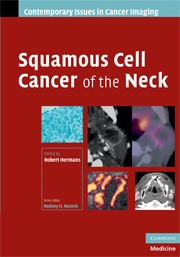Book contents
- Frontmatter
- Contents
- List of contributors
- Series Foreword
- Preface to Squamous Cell Cancer of the Neck
- 1 Introduction: epidemiology, pathology and clinical presentation
- 2 Radiotherapy and chemoradiotherapy of the head and neck
- 3 Surgery of the orocervical region
- 4 Laryngeal and hypopharyngeal cancer
- 5 Oral cavity and oropharyngeal cancer
- 6 Nasopharyngeal cancer
- 7 Neck and distant disease spread
- 8 Post-treatment imaging
- Index
- Plate section
- References
1 - Introduction: epidemiology, pathology and clinical presentation
Published online by Cambridge University Press: 24 August 2009
- Frontmatter
- Contents
- List of contributors
- Series Foreword
- Preface to Squamous Cell Cancer of the Neck
- 1 Introduction: epidemiology, pathology and clinical presentation
- 2 Radiotherapy and chemoradiotherapy of the head and neck
- 3 Surgery of the orocervical region
- 4 Laryngeal and hypopharyngeal cancer
- 5 Oral cavity and oropharyngeal cancer
- 6 Nasopharyngeal cancer
- 7 Neck and distant disease spread
- 8 Post-treatment imaging
- Index
- Plate section
- References
Summary
In general in the head and neck, two major groups of malignant neoplasms can be recognized. A smaller but important group of neoplasms can be described as “glandular neoplasms,” the majority arising in the thyroid, a minority in the salivary glands. These tumors are not considered in this chapter. This chapter deals specifically with the largest group of malignancies, so-called squamous cell carcinoma (SCC) of the head and neck (HNSCC). These account for about 90% of all head and neck cancers and originate in the mucosal membranes of the upper aerodigestive tract. Squamous cell carcinoma also arises from the skin. Skin cancer is generally considered a separate entity, as is skin cancer of the head and neck.
Head and neck neoplasia observed less frequently include localized lymphoma, soft tissue and bone sarcomas, and neuroectodermal tissue tumors (paraganglioma, olfactory neuroblastoma, neuroendocrine carcinoma, malignant melanoma). As this volume deals specifically with HNSCC, the reader is referred to specific oncological literature for information on other neoplasms.
This chapter deals with the epidemiology, pathology and clinical presentation of premalignant and malignant head and neck neoplasms.
Epidemiology: frequency measures and risk factors
Incidence
Head and neck cancer, excluding skin cancer and Hodgkin and non-Hodgkin lymphoma, is the sixth most frequent cancer in the world. Approximately 500 000 new malignancies of the mucous membranes are registered per year (oral and pharyngeal cancer: 363 000 new cases and 200 000 deaths yearly; laryngeal cancer: 136 000 new cases and 73 500 deaths yearly).
- Type
- Chapter
- Information
- Squamous Cell Cancer of the Neck , pp. 1 - 18Publisher: Cambridge University PressPrint publication year: 2008



